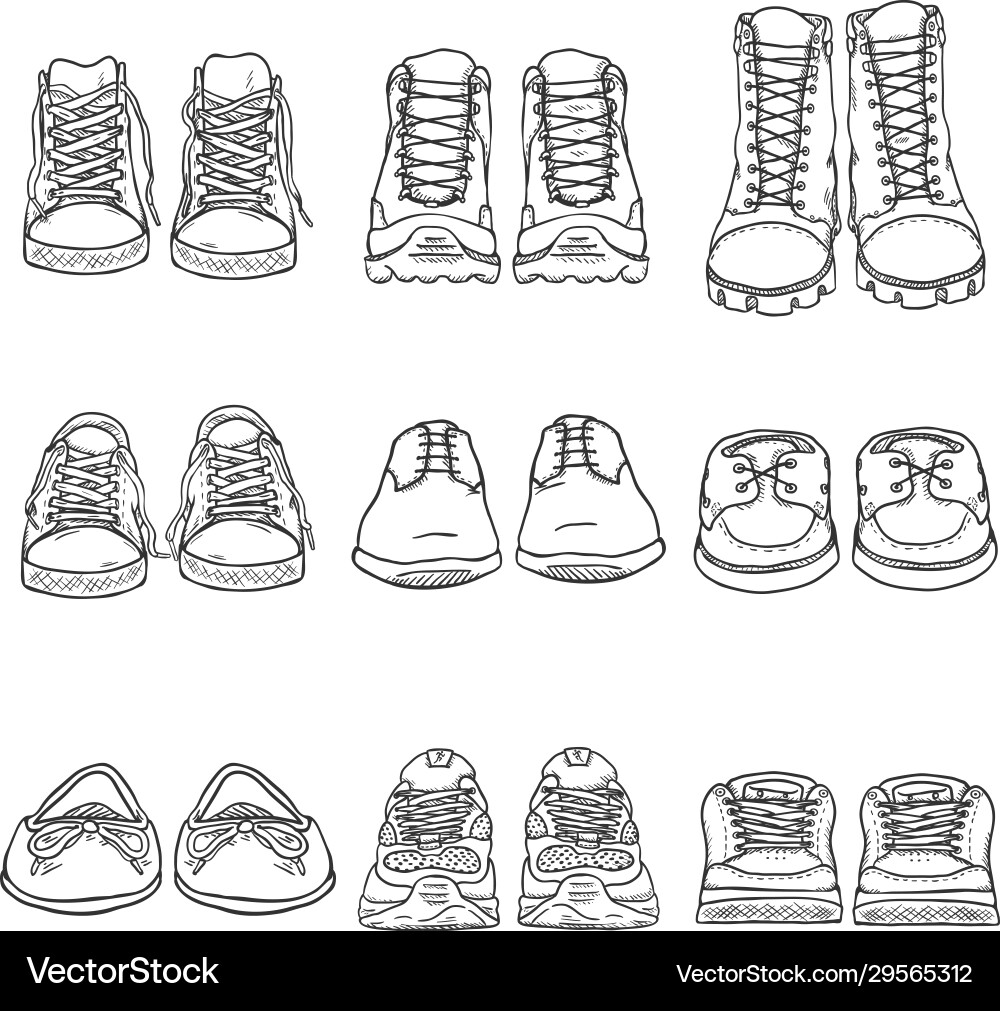The question often arises: How do you draw shoes from the front view? Drawing shoes, especially from the front, might seem tricky at first. This article provides a shoe drawing tutorial front, breaking down the process of drawing shoes step by step front view. We’ll explore shoe sketching for beginners front, learn how to draw sneakers front, and create a compelling front view shoe illustration. You’ll also learn about shoe anatomy drawing front, perspective drawing shoes front, drawing shoe laces front, and how to achieve a realistic shoe drawing front. We’ll even look at an easy shoe drawing front view method.

Image Source: cdn.vectorstock.com
Getting Started: Basic Shapes and Proportions
Before diving into details, let’s start with the foundation: basic shapes and proportions. Think of the shoe as a collection of simple geometric forms. This approach makes the task far less intimidating.
The Initial Sketch: Boxes and Cylinders
Start with boxes. Imagine a box for the main body of the shoe (the vamp and quarters) and another for the sole. These boxes act as guides for the overall shape and size.
- The Sole Box: Draw a rectangle. Its length will determine the shoe’s overall length.
- The Body Box: Place another box on top of the sole box. This one defines the height of the shoe’s upper part.
- The Toe Box: Add a smaller, rounded box at the front to represent the toe area.
Once you have these basic shapes, refine them. Round off the corners and adjust the sizes to match the type of shoe you want to draw.
Establish the Correct Proportions
Proportion is key. If the proportions are off, the drawing will look unnatural. Here are some guidelines:
- Length vs. Height: Generally, the height of the shoe (from sole to the top) is roughly one-third to one-half of its length.
- Toe Area: The toe area should occupy about one-quarter to one-third of the shoe’s total length.
- Sole Thickness: The sole’s thickness varies greatly depending on the shoe style. Consider its ratio to the overall height.
Fathoming Shoe Anatomy
To draw realistically, you need to grasp the basic anatomy of a shoe. While designs vary, certain elements remain consistent. The table below gives a simplified overview.
| Part | Description |
|---|---|
| Outsole | The bottom layer that contacts the ground. |
| Midsole | The cushioning layer between the outsole and insole. |
| Insole | The inner layer that the foot rests on. |
| Vamp | The front part of the upper, covering the toes and part of the foot. |
| Quarters | The sides of the upper, extending from the vamp to the heel. |
| Heel Counter | The back part of the shoe that supports the heel. |
| Tongue | A strip of material under the laces, protecting the foot. |
| Laces/Fasteners | Used to tighten or loosen the shoe. |
Key Anatomical Considerations
When drawing, pay special attention to how these parts connect and overlap. For instance, the vamp usually curves smoothly into the quarters, while the heel counter provides a distinct shape at the back.
Applying Perspective
Perspective is crucial for a believable front view shoe illustration. Even though you’re drawing a front view, a touch of perspective adds depth.
Linear Perspective: Vanishing Points
- Slight Angle: Imagine the shoe is turned very slightly to one side. This introduces a subtle perspective.
- Vanishing Points: Establish two vanishing points far off to the sides of your paper. Lines representing the sides of the shoe will converge towards these points.
Foreshortening
Foreshortening is how objects appear shorter when viewed at an angle. In a front view, the sides of the shoe will be slightly foreshortened, making them appear shorter than the central part.
Curvilinear Perspective
Shoes are rarely perfectly flat. They curve around the foot. Use curved lines to emphasize this three-dimensional form.
Drawing Different Shoe Styles
Different shoes have distinct features. Let’s look at how to draw sneakers front, boots, and dress shoes.
Sneakers
Sneakers are known for their sporty design and often feature prominent soles, visible stitching, and various panels.
- Sole Details: Emphasize the sole’s thickness and texture. Add lines to show the different layers (outsole, midsole).
- Panel Lines: Use lines to define the different panels of the upper. This adds complexity and realism.
- Logos and Branding: Include subtle details like logos to enhance the brand identity.
Boots
Boots are characterized by their higher shaft, which extends above the ankle.
- Shaft Height: Accurately represent the height of the boot shaft. This is a defining feature.
- Buckles and Straps: Add details like buckles, straps, and stitching to create a rugged look.
- Heel Shape: Pay attention to the heel’s shape and size. Boots often have more substantial heels than other shoe types.
Dress Shoes
Dress shoes typically have a sleek and formal appearance.
- Clean Lines: Focus on clean, smooth lines to convey elegance.
- Minimal Details: Keep the details minimal. Avoid excessive stitching or embellishments.
- Polished Surface: Suggest a polished surface through subtle shading and highlights.
Detailing: Laces, Stitching, and Textures
The details bring your realistic shoe drawing front to life.
Drawing Shoe Laces Front
Laces can seem daunting, but break them down into manageable steps.
- Placement: First, sketch the general path of the laces. Start with the points where they enter and exit the shoe’s eyelets.
- Overlapping Strands: Draw the laces as overlapping strands. Show how they weave over and under each other.
- Knot: Don’t forget the knot! It’s a key detail that adds realism.
- Thickness: The laces should have consistent thickness, with minor variations to indicate tension and slack.
Stitching
Stitching adds a sense of craftsmanship.
- Placement: Identify where stitching would naturally occur, such as along the edges of panels and seams.
- Line Weight: Use thin, consistent lines to represent the stitching.
- Consistency: Keep the spacing between stitches even for a neat appearance.
Textures
Textures add depth and realism.
- Leather: Use short, irregular strokes to suggest the texture of leather.
- Canvas: Use a cross-hatching pattern to represent canvas.
- Rubber: Use smooth shading to show the sheen of rubber soles.
Shading and Highlights
Shading and highlights define the form and create depth.
Light Source
Establish a light source. This will determine where the shadows and highlights fall.
Gradual Shading
Use gradual shading to create smooth transitions between light and shadow. Use a pencil with a soft lead (2B or 4B).
Highlights
Highlights represent the areas where light directly hits the surface. Use an eraser to lift graphite and create bright spots.
Cast Shadows
Cast shadows are the shadows that the shoe casts onto the ground. These shadows help to ground the shoe and give it weight.
Easy Shoe Drawing Front View: Simplified Approach
Looking for an easy shoe drawing front view method? Here’s a simplified approach:
- Basic Outline: Start with a simple oval shape. This will be the main body of the shoe.
- Sole: Add a flat rectangle underneath the oval for the sole.
- Toe: Add a small curve for the toe area.
- Details: Add basic details like laces and a simple pattern for the sole.
- Shading: Add minimal shading to suggest depth.
This method is perfect for quick sketches and practicing basic shapes.
Shoe Sketching for Beginners Front: Tips and Tricks
Here are some tips to help shoe sketching for beginners front:
- Practice Regularly: The more you practice, the better you’ll become.
- Use References: Look at real shoes or photos of shoes.
- Break Down Complex Shapes: Simplify complex shapes into basic geometric forms.
- Focus on Proportions: Pay attention to the proportions of the shoe.
- Don’t Be Afraid to Erase: Erasing is part of the process.
Front View Shoe Illustration: Adding Style and Flair
To elevate your front view shoe illustration, experiment with different styles and techniques.
Stylization
Try exaggerating certain features or simplifying others.
Color
Add color to your illustrations using markers, colored pencils, or digital tools.
Background
Create a background that complements the shoe. A simple gradient or a stylized environment can add visual interest.
Line Weight Variation
Use different line weights to create visual hierarchy. Thicker lines can define the outer edges, while thinner lines can represent interior details.
Frequently Asked Questions (FAQ)
- What’s the hardest part about drawing shoes? Getting the proportions right and accurately representing the curves and contours.
- Can I use a grid to help with proportions? Yes, a grid can be a helpful tool for maintaining accurate proportions, especially for beginners.
- What kind of pencil should I use? A range of pencils from HB to 4B is useful. HB for light sketches and 2B or 4B for shading.
- How do I draw different textures? Experiment with different pencil strokes and shading techniques. Use reference images to guide you.
- How long does it take to get good at drawing shoes? It varies depending on your dedication and practice. Consistent practice will yield noticeable improvements over time.
Drawing shoes from the front view requires patience and practice. By breaking down the process into manageable steps, focusing on proportions, and paying attention to detail, you can create compelling and realistic shoe illustrations.

David Ruperto is a Footwear Engineer with expertise in 3D printing, design, and pattern making. With a background in Fine Arts from CUNY and training from SLEM and Cordwainer’s Savannah, he blends creativity with innovation. Based in New York, he shares his knowledge on BestForShoes.com, helping others explore the world of footwear.
